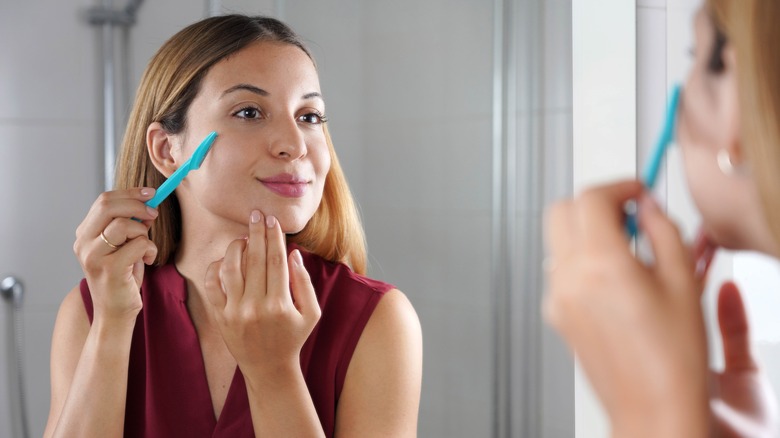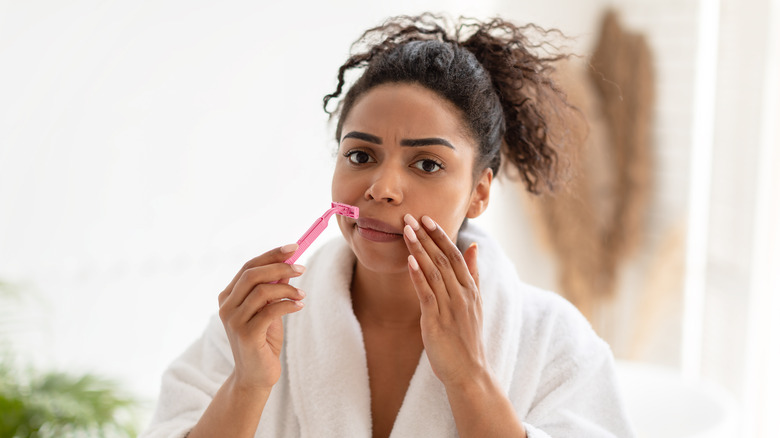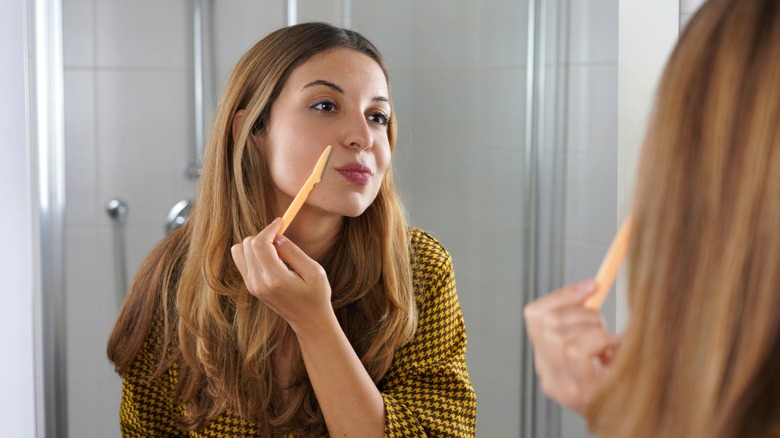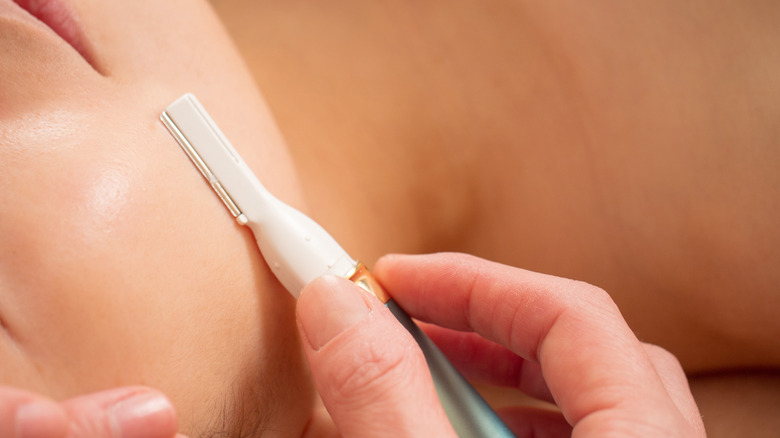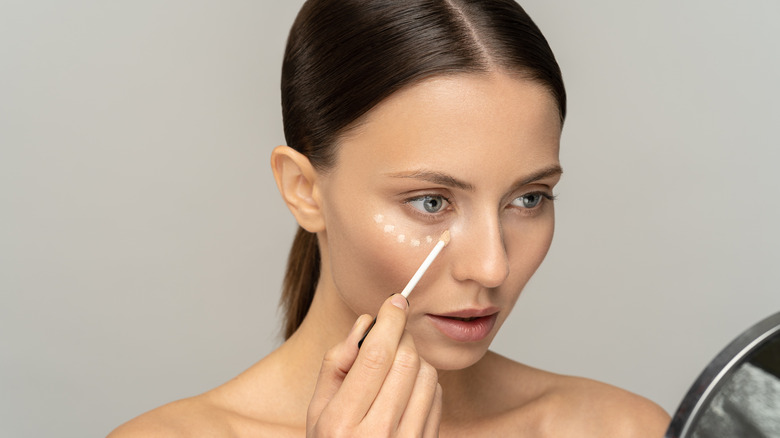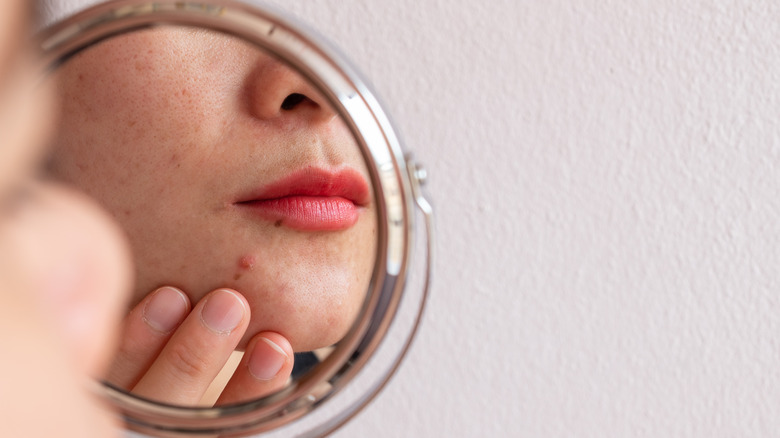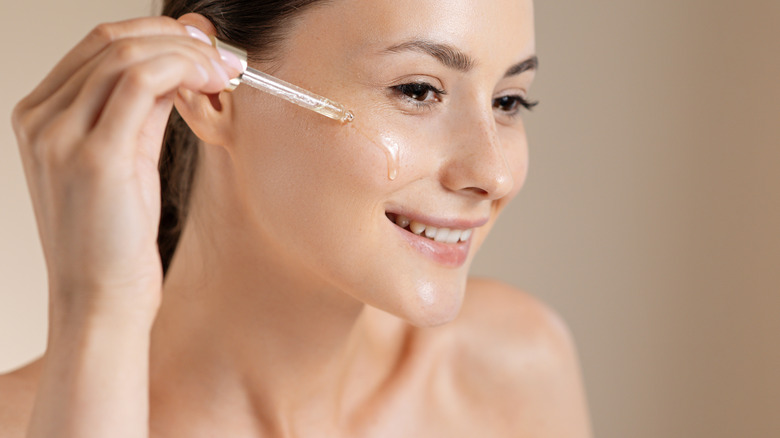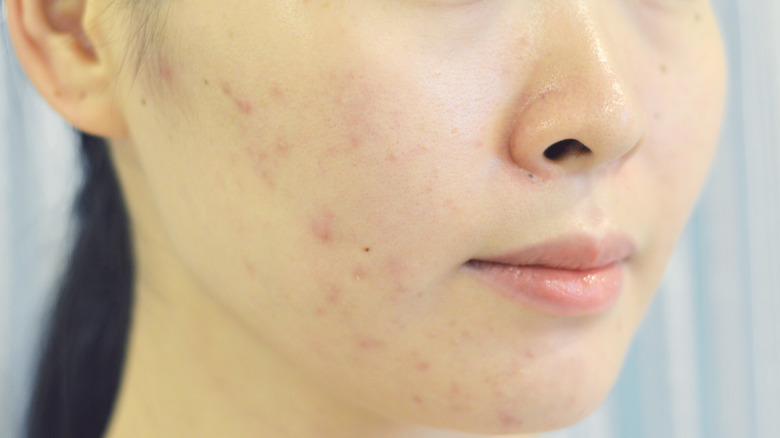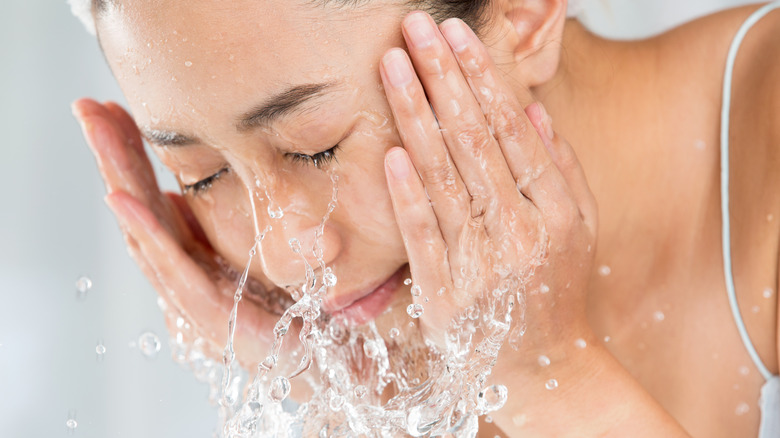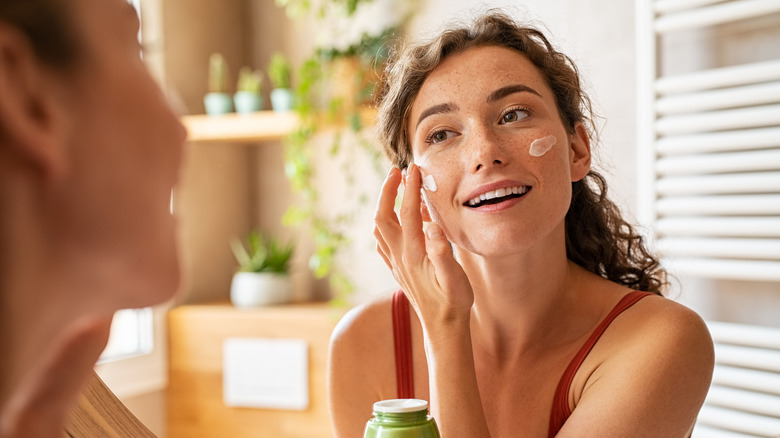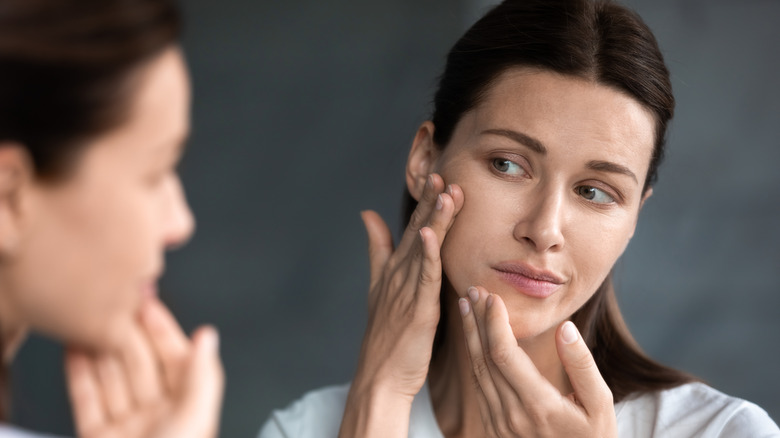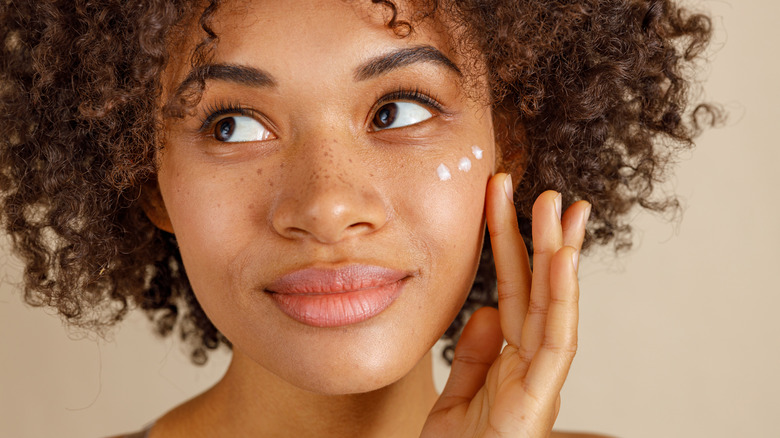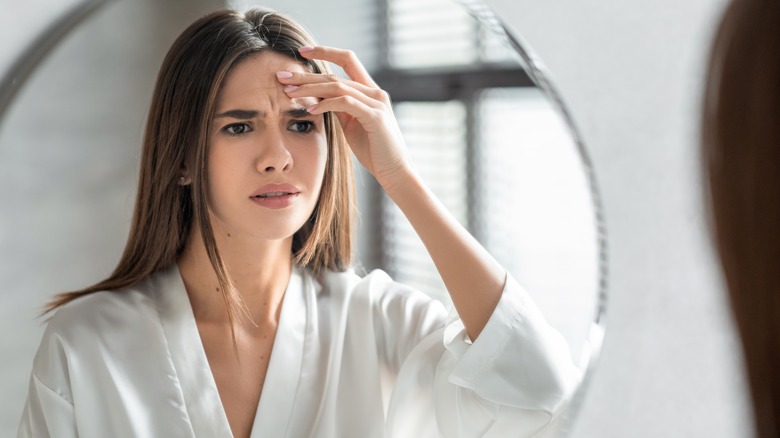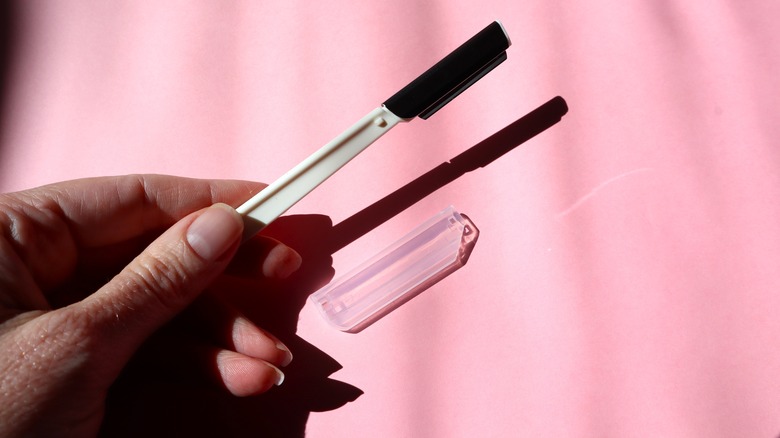What Really Happens When Women Shave Their Face
We may receive a commission on purchases made from links.
Dermaplaning, also known as shaving your face, has become increasingly popular thanks to social media platforms like TikTok and Instagram, where users share their experiences and tips for attempting the treatment at home.
While there are plenty of benefits of shaving your face at home, keep in mind that you can never replicate dermaplaning in the way a professional does it. If you have the financial means and time, it's always best to have a dermatologist do it. The pros can see your skin better than you ever will in a mirror, they have plenty of experience performing the skin treatment, and their razors are much sharper, which means the results will be better. "Dermaplaning is a physical form of exfoliation similar in theory to microdermabrasion," cosmetic surgeon and skin expert Dr. Jonquille Chantrey tells Refinery29. "It requires the use of a sterile, surgical scalpel (not as scary as it sounds) to gently shave the skin's surface, removing the top layer of dead skin along with fine vellus hair."
That said, it is definitely still possible to shave your face at home, and we assembled a list of everything you need to know — good and bad — before you tackle getting rid of your peach fuzz.
You will exfoliate your skin
One of the most visible outcomes of face shaving is exfoliation. "It's more than just a method for hair removal. It's a much deeper exfoliation treatment," Azadeh Shirazi, a cosmetic dermatologist, tells USA Today. In fact, safely shaving your face at home is comparable to professional exfoliating.
"Shaving your face can have somewhat similar results to a professional dermaplane procedure," esthetician Kerry Benjamin tells Byrdie. "Dermaplaning provides a deeper exfoliation than shaving at home, but they both remove the dead outer skin and vellus hairs."
Because shaving exfoliates in addition to removing hair, you can gently tackle areas that don't necessarily have hair, such as your nose. However, keep in mind that if you shave your face, you've already exfoliated it — so you don't need to use any additional exfoliation methods, as those could cause redness and irritation. And just like exfoliating with traditional methods, don't overdo it!
You will get a cleaner shave using a facial razor
If you decide to try face shaving, know that the kind of razor you use does matter. For the best results, you should use a facial razor meant for dermaplaning. "It's different from a regular razor because you can get a better angle with the long dermaplaning tools, and it's also less sharp than razors, which are meant to cut thick hairs," Mona Gohara, a dermatologist and associate clinical professor of dermatology at Yale University, tells USA Today.
If you shave with a regular razor, you probably won't get a clean result, some hairs will still be on your face, and the exfoliation benefits won't be as prominent. "Dermaplaning is similar to shaving; however, the tool is better suited to exfoliate the epidermis than a razor," board-certified dermatologist Audrey Kunin tells Byrdie.
You can buy a set of three razors at Ulta Beauty for $8. Keep in mind that a facial razor is not reusable as it is prone to bacteria build-up. The blade also becomes dull quickly, which is why you should throw it out once you're done shaving your face. "Be sure to always use a fresh razor, I wouldn't recommend reusing a razor, especially if you are acne prone, board-certified dermatologist Dr. Deanne Robinson, M.D., tells The Zoe Report.
Your facial hair won't grow longer or thicker
A common myth that tends to prevent people from shaving their face is the fear that their facial hair will grow back thicker and longer. However, this is not the case. "That myth exists because people mistake the wispy feeling of their unshaven facial hair with the slightly blunt feeling of their clean-shaven facial hair as it starts to grow back," board-certified dermatologist Neal Schultz, M.D., tells Cosmopolitan. "So it's more about what you're feeling and seeing versus what is actually going on."
Shaving doesn't affect hair thickness, factors like age, hormones, and genetics do, according to Mona Gohara, a dermatologist and associate clinical professor of dermatology at Yale University (via USA Today). Esthetician Kerry Benjamin confirms to Byrdie that shaving won't make your hair darker either, which is another common hair-shaving myth. "You aren't changing the structure of the follicle," Benjamin says.
However, if the only reason you want to try shaving your face is to get rid of your hair, you should perhaps consider other methods. "Those that [have] excess facial hair are better off having treatments such as regular waxing, threading or, better still, laser hair removal," cosmetic surgeon and skin expert Dr. Jonquille Chantrey suggests to Refinery29. "Although these treatments do not permanently remove the hair, and maintenance treatments may be required, I do believe that they are still better options than dermaplaning."
Your makeup will go on much smoother
If you wear face makeup regularly, you will definitely notice a change in how it applies after you shave your face. Even if you don't necessarily have visible facial hair that you want to get rid of, shaving the peach fuzz off your cheeks and forehead will result in a much smoother makeup application.
"While those soft, vellus hairs can be helpful, they also hold onto makeup, dirt, bacteria, and a whole bunch of irritants," Cassandra Bankson, a skincare expert and medical esthetician, tells USA Today. "I found that when I dermaplaned my face, my selfies turned out crisper because the powdered makeup wouldn't hold onto my facial hairs."
Don't even get us started on the way highlighter will look — your skin will glow in all the right places even without you applying any product. Trust us, once you give it a go, it is likely that shaving your face will become a regular part of your weekly routine.
You shouldn't shave if you have a damaged skin barrier, sensitive skin, or acne
Just like any other skincare procedure, however, facial shaving isn't for everyone. It can be a rather harsh form of exfoliation for some as you're literally shaving the dead skin off — so making sure you have well-hydrated and irritation-free skin before doing it is a must."You need a strong skin barrier," cosmetic dermatologist Azadeh Shirazi, tells USA Today. "[Facial shaving] can worsen skin conditions or flare them up, so be sure to first consult with your dermatologist and treat your skin before trying any at-home treatments."
"If you have sensitive skin, acne, active eczema, or other rashes, dermaplaning is not advised," board-certified dermatologist Audrey Kunin tells Byrdie. Facial shaving doesn't mean you need to shave your whole face, though. If you have flakiness or redness on your cheeks and forehead, you should skip the process, but if you want to shave your sideburn peach fuzz, for example, you can still do that safely. Just make sure you don't shave over any irritated spots.
You should try oilplaning, a gentler version of dermaplaning
While you don't have to use oil to shave your face, it is recommended as it helps the blade glide smoothly and creates a protective barrier on your skin that prevents irritation. "The idea is that by first applying a facial oil rich in emollients, you're helping to protect the skin barrier and increase the glide — comparable to using a shaving cream/gel/oil before shaving to reduce the risk of irritation and nicks," board-certified dermatologist Dr. Hadley King tells The Zoe Report.
For this, you don't need to buy a special oil. If you already have a preferred facial oil, you can use that, but if you don't, consider getting grapeseed, coconut, argan, rosehip seed, or jojoba oil (via Healthline). "Make sure the oil is not heavily fragranced with essential oils, which could cause discomfort to your skin, or too heavy, which can clog pores," board-certified dermatologist Dr. Macrene Alexiades notes for The Zoe Report.
Your face might break out
We already established that if you have acne, you shouldn't take a razor over it. Not only will this irritate the area, but you might end up cutting yourself, as acne often protrudes out from the skin and causes texture. Apart from that, if you get breakouts easily but your face is currently calm, keep in mind that shaving it could result in a breakout.
"Hairs on the face have the purpose of [pulling] oil [from our skin] onto the outer surface," Cassandra Bankson, a skincare expert and medical esthetician, tells USA Today. "If you were to shave those hairs off, those oils could still potentially stay in the skin ... which could trap everything inside and cause a pimple."
This doesn't mean that a breakout is 100% guaranteed. Because everyone's skin is different, you'd need to try face shaving yourself to know how your skin will react.
You may cause irritation if you don't cleanse properly afterward
If you decide to shave your face, you absolutely need to clean it properly afterward. "Gently cleanse the skin to remove the dermaplaned dead skin cells and hair," board-certified dermatologist Dr. Hadley King tells The Zoe Report. For this, it's best to use a gentle cleanser with ceramides and hyaluronic acid. Basically, you want to avoid anything with harsh ingredients and a strong scent.
Apart from the right cleanser, keep in mind that your skin is very sensitive, and hot water will irritate it. Make sure you wash it with lukewarm water and don't use a facial cleansing brush. Your fingers and gentle pressure are perfect.
If you don't cleanse your skin properly but immediately apply serums and moisturizers, you will end up trapping dirt, hair, and oil under the skincare products. This will most likely result in breakouts, redness, inflammation, and irritation, which you may then wrongly attribute to being caused by face shaving.
Your skin can dry out so moisturizing is key
Since face shaving also exfoliates your skin, it can cause some skin barrier damage, which is why using heavy-duty moisturizers after the process is crucial. "Dermaplaning lessens the skin barrier," dermatologist and founder of Dr. Loretta Skincare, Loretta Ciraldo, M.D., tells Glamour. "This means your products will penetrate more effectively, but it also means skin can become drier since there is less barrier to prevent water loss."
Using a serum with hyaluronic acid on wet skin is a great way to rehydrate your skin quickly. "Hyaluronic acid is a moisture magnet," Nicolas Travis, the founder of Allies of Skin, tells Refinery29. "But if your skin is dry, it pulls any residual moisture from the deeper layers of skin to hydrate the surface. In that case, you need to apply it to moist skin — which is why you should mist it first and then apply a hyaluronic acid treatment afterward. Once hyaluronic acid comes into contact with water, it knows what it's doing, and your skin will end up supremely hydrated and plumped."
If you want to take it a step further, consider using a bottle of thermal water — which is taken from natural springs, according to Healthline — instead of your regular tap water. Once the hyaluronic acid serum soaks in, put a generous layer of your favorite moisturizer on top of it.
You might get ingrown hairs
As with any area of your body that you shave, ingrown hairs can also occur on your face. While anyone can get ingrown hairs once in a while, you are more likely to get them if you aren't taking proper care of your skin from the beginning. "To prevent ingrown chin hair, for example, make sure to wash your face daily with a cleanser to remove oil, dead skin cells, dirt, makeup, or other impurities from clogging your follicles," Somenek + Pittman's Dr. Michael Somenek, tells Byrdie. "Clogged follicles can grow sideways or become stuck, causing ingrown hair."
If you do end up getting a few ingrown hairs, do not attempt to squeeze them out. "Don't pick at it and try and get it out yourself," dermatologist Jordan C. Carqueville tells Byrdie. "We don't recommend people do that at home because it's breaking into the skin, which can lead to scarring and infections." Instead, exfoliate the area regularly and after a couple of days, the hair should work its way out on its own.
Your skincare products will absorb much better
Because shaving your face does a great job of exfoliating it, your skincare products will absorb much better. After you shave, make sure you use hydrating and calming products that help nourish your skin deeply and help keep its barrier healthy. "Dermaplaning prepares your skin to accept topical skincare ingredients more rapidly and evenly, so a nice serum post dermaplaning is a great idea," Dr. Stafford Broumard tells Byrdie. "Vitamin C serum is a popular choice. Growth factors, peptides, and other powerhouse ingredients can be used."
However, the fact that products will absorb more deeply isn't always a great thing, as some products are more likely to cause a lot more irritation that way. One of those product categories is retinoids, which are known to irritate the skin if used too frequently. According to board-certified dermatologist Julia Siegel, M.D., retinol's "ability to absorb and do its thing is greater and therefore the potential for irritation is slightly greater" (via Byrdie). Other skincare products and ingredients you should avoid for at least a day after you shave your face include benzoyl peroxide, glycolic acid, salicylic acid, and astringents, according to AB Clinical.
Your fine lines may become less visible
According to The Skin and Wellbeing Clinic Preston, dermaplaning can help wrinkles and fine lines look less prominent by exfoliating the skin and removing tiny hairs that might increase the appearance of any skin creasing. "Dermaplaning's purpose is to give your skin an immediate exfoliation for a luminous glow that lasts a week," Dr. Stafford Broumard tells Byrdie. "The benefits are dewy skin, faster cell turnover, and a smoother texture."
Of course, if you have very prominent wrinkles, you might not notice a huge difference, but those with fine lines will definitely see an improvement. However, if you have crow's feet, stay away from dermaplaning around your eyes. Since the skin around your eyes is very thin, it's hard to shave it, and more frequently than not, you may just end up cutting yourself. You can, however, use a facial razor to shave around your eyebrows; just make sure you're very careful.
You can injure your skin if you're not careful
If you have never tried dermaplaning before and you're wondering what really happens when you shave your face, it's important to note that while the treatment can have amazing benefits, it can also result in a lot of damage if you aren't careful. "Done improperly, you can leave marks, scars, cuts, scrapes, open areas, inflame the skin, or worsen acne," dermatologist Mona Gohara, M.D. tells Glamour.
Apart from having the right razor and facial oil to use, make sure you have plenty of time on hand — never shave your face in a rush. And don't forget to clean your face before you shave it. "You want to really clean your face well before taking a razor to it," board-certified dermatologist Dr. Deanne Robinson, M.D., tells The Zoe Report. "This avoids transporting bacteria and oils into open pores as you slough off dead skin cells with each swipe."
Finally, to make the most of the at-home treatment, make sure to wash your face well afterward and apply the appropriate serums and a good moisturizer.
